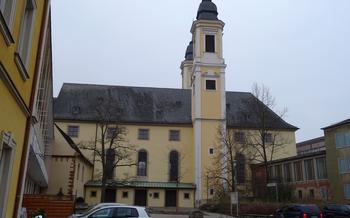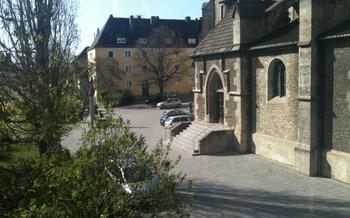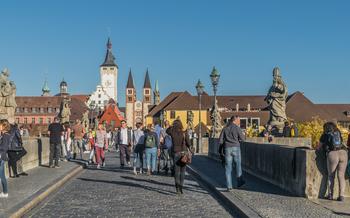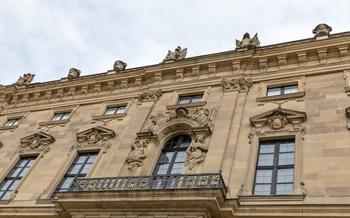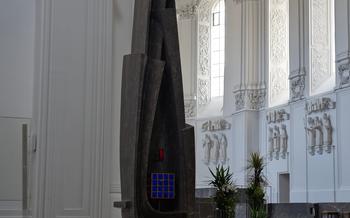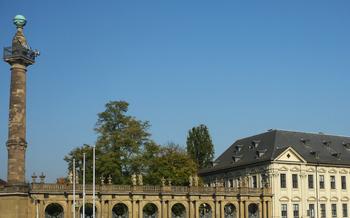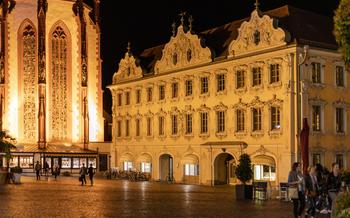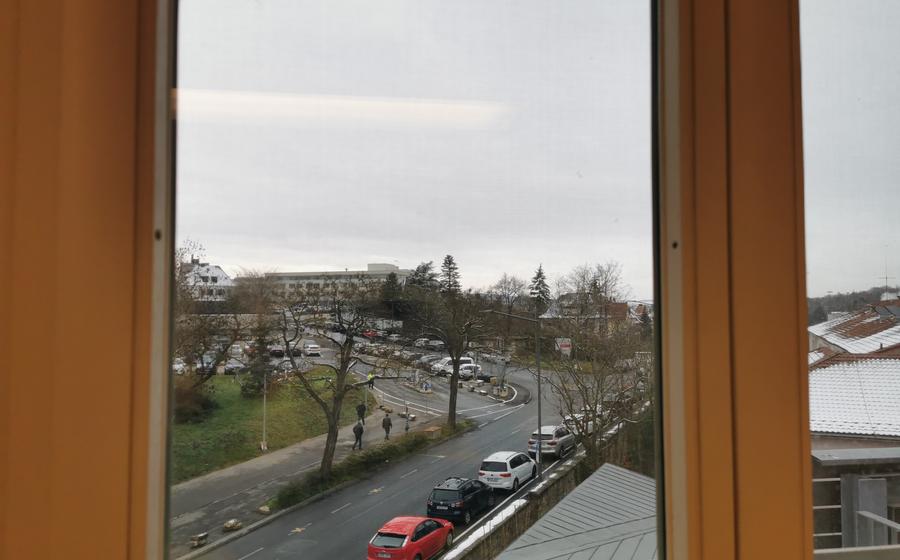
St. Elisabeth in Versbach
- St. Elisabeth Church in Versbach: A Stunning Gem of Baroque Architecture
- A Journey Through Time: The History of St. Elisabeth Church
- Unveiling the Architectural Masterpiece
- Exploring the Pilgrimage Route: A Path of Faith and Devotion
- Honoring St. Elisabeth: A Symbol of Compassion and Charity
- Discovering Hidden Treasures: The Art and Sculptures of St. Elisabeth Church
- A Place of Worship and Contemplation: The Sanctuary and Altar
- Immerse in the Sounds of Faith: The Organ of St. Elisabeth Church
- A Village Steeped in History: Exploring Versbach
- Plan Your Pilgrimage: Practical Tips for Visitors
- Capture the Essence: Photography Tips for St. Elisabeth Church
- Dress Code and Etiquette: Respecting Sacred Spaces
- Beyond St. Elisabeth: Exploring the Region's Treasures:
- Insider Tip: Unveiling a Hidden Gem
St. Elisabeth Church in Versbach: A Stunning Gem of Baroque Architecture
Nestled in the picturesque village of Versbach, just a short distance from the vibrant city of Würzburg, stands the magnificent St. Elisabeth Church. This Baroque masterpiece, with its soaring twin towers and intricate facade, is a testament to the region's rich history and artistic heritage. The church holds a special significance as a pilgrimage site, attracting countless visitors each year who come to pay homage to St. Elisabeth of Hungary, a beloved figure known for her compassion and charity. Planning a visit to St. Elisabeth Church promises a journey through time, art, and spirituality, leaving an indelible mark on every traveler's soul.
A Journey Through Time: The History of St. Elisabeth Church
In the heart of Versbach, the story of St. Elisabeth Church unfolds, a tale that begins in the 13th century. Augustinian Hermits, drawn to the region's tranquil beauty, sought to establish a place of worship and community. Thus, in 1280, the foundation stone was laid, marking the birth of this architectural gem.
The church's construction stretched across decades, shaped by the hands of skilled craftsmen and the unwavering dedication of the Augustinians. As the walls rose, they bore witness to the changing times, the shifting tides of history. The church stood steadfast, a silent observer of the Thirty Years' War that ravaged the land, leaving scars that echoed through the ages.
Despite the trials and tribulations, St. Elisabeth Church emerged triumphant. In the 18th century, a wave of restoration and preservation swept over the edifice, breathing new life into its aging structure. Baroque elements harmoniously blended with the existing Gothic foundations, creating a captivating fusion of architectural styles.
Today, St. Elisabeth Church stands as a testament to resilience, a symbol of faith that has endured the passage of time. Its history is interwoven with the lives of countless individuals who sought solace, guidance, and spiritual renewal within its hallowed walls.
Unveiling the Architectural Masterpiece
The St. Elisabeth Church in Versbach stands as a testament to the grandeur of Baroque architecture, captivating visitors with its intricate details and symbolic elements. The exterior facade exudes a sense of majesty, with its vibrant colors and expressive sculptures adorning the entrance. The twin towers, reaching towards the heavens, symbolize the church's connection to the divine and serve as a beacon of hope for pilgrims seeking solace and guidance.
Stepping inside, one is met with an awe-inspiring display of Baroque artistry. The interior boasts a harmonious blend of light and shadow, creating a mystical atmosphere that invites contemplation. The intricate ceiling frescoes, painted by talented artists, depict scenes from the life of St. Elisabeth and other biblical narratives, adding a touch of celestial beauty to the sacred space.
The altar, the focal point of the church, commands attention with its elaborate carvings and gilded ornaments. It serves as a reminder of the sacrificial nature of Christ's love and the importance of devotion in the Catholic faith. The tabernacle, housed within the altar, is a symbol of the Real Presence of Christ in the Eucharist, a central tenet of Catholic belief.
Throughout the church, visitors can admire the exquisite sculptures and paintings that adorn the walls and alcoves. Each artwork tells a story, portraying biblical figures, saints, and scenes from the life of St. Elisabeth. The attention to detail and the mastery of the artists are evident in every piece, adding to the church's rich artistic heritage.
Exploring the architectural masterpiece of St. Elisabeth Church is a journey through history, art, and faith, leaving visitors with a profound sense of awe and inspiration.
Exploring the Pilgrimage Route: A Path of Faith and Devotion
In the realm of Catholicism, pilgrimage holds a significant place, serving as a journey of spiritual growth and devotion. St. Elisabeth Church in Versbach has been a renowned pilgrimage site for centuries, attracting believers from far and wide. According to legend, St. Elisabeth possessed miraculous healing powers, and pilgrims sought her intercession for cures and blessings.
The pilgrimage route from Würzburg to Versbach, a distance of approximately 15 kilometers, is a testament to the enduring faith and dedication of pilgrims. This route, often undertaken on foot, provides a unique opportunity for spiritual reflection and contemplation. Along the way, pilgrims encounter wayside crosses, shrines, and chapels, each holding a special significance in the pilgrimage tradition.
Upon reaching Versbach, pilgrims are greeted by the majestic St. Elisabeth Church, the culmination of their journey. Here, they can participate in Mass, venerate the relics of St. Elisabeth, and seek her intercession through prayer. The church also offers guided tours and informational displays, allowing visitors to delve deeper into the history and significance of the pilgrimage site.
Whether undertaken as a religious devotion or a cultural exploration, the pilgrimage to St. Elisabeth Church in Versbach is an enriching experience that offers a glimpse into the deep-rooted traditions of Catholicism and the enduring legacy of St. Elisabeth.
Honoring St. Elisabeth: A Symbol of Compassion and Charity
In the heart of St. Elisabeth Church lies the story of a remarkable woman whose legacy continues to inspire and touch lives. St. Elisabeth of Hungary, born into royalty in 1207, dedicated her life to alleviating the suffering of the poor and sick. Her unwavering compassion and selfless acts of charity earned her sainthood, and her spirit lives on within the walls of this sacred space.
The church serves as a testament to St. Elisabeth's unwavering devotion to helping those in need. Throughout her life, she tirelessly worked to establish hospitals, provide food and shelter to the destitute, and care for the sick. Her unwavering commitment to serving the marginalized and vulnerable earned her the title of "Patron Saint of the Poor and Sick."
Within the church, visitors can find depictions of St. Elisabeth's charitable acts, showcasing her unwavering dedication to alleviating human suffering. These artistic representations serve as a reminder of her profound compassion and the enduring impact of her legacy. Stories and legends surrounding St. Elisabeth's life, passed down through generations, continue to inspire and remind us of the power of compassion and the importance of serving those in need.
St. Elisabeth Church stands as a symbol of her unwavering commitment to charity and serves as a reminder to all who visit of the profound impact that one person's compassion can have on the world. Her legacy continues to inspire countless individuals to follow in her footsteps and make a positive difference in the lives of others.
Discovering Hidden Treasures: The Art and Sculptures of St. Elisabeth Church
The interior of St. Elisabeth Church is a treasure trove of artistic masterpieces, each imbued with profound symbolism and iconography. Adorning the walls and altars are exquisite sculptures and paintings, crafted by renowned artists and artisans. The intricate details and lifelike expressions of the figures captivate the viewer, inviting them to delve deeper into the stories and teachings they represent.
One of the highlights of the church's art collection is the stunning altarpiece, a masterpiece of Baroque artistry. Carved from wood and adorned with intricate golden embellishments, it depicts scenes from the life of St. Elisabeth, her acts of charity, and her unwavering faith. The vibrant colors and dynamic compositions bring the narrative to life, inspiring awe and contemplation.
Another must-see is the series of sculptures adorning the pillars and niches of the church. These life-size figures represent various saints and martyrs, each with their own unique attributes and symbolism. Their serene expressions and graceful postures create a sense of tranquility and devotion within the sacred space.
The ceiling frescoes, painted by talented artists of the Baroque period, are a testament to the church's rich artistic heritage. Depicting biblical scenes and allegorical representations of virtues, they add a layer of grandeur and spirituality to the interior. The use of light and shadow, combined with the vivid colors and intricate brushwork, creates a sense of wonder and transcendence.
As you explore the church, take time to admire the smaller details that contribute to its artistic tapestry. The stained glass windows, with their vibrant hues and intricate patterns, cast a warm and colorful glow upon the interior. The intricately carved confessionals and pulpits are adorned with delicate ornaments and biblical motifs, adding to the overall aesthetic beauty of the church.
A Place of Worship and Contemplation: The Sanctuary and Altar
The sanctuary in St. Elisabeth Church is a sacred space that exudes an aura of reverence and devotion. It serves as the focal point of religious ceremonies and offers a place for worshippers to connect with the divine. The elaborate altar, adorned with intricate carvings and symbolic imagery, stands as a testament to the church's rich artistic heritage. The tabernacle, housed within the altar, holds a special significance, symbolizing the presence of Christ in the Eucharist. The sanctuary invites visitors to pause and reflect on the profound spiritual significance of this sacred space, encouraging a deeper connection with the divine.
Immerse in the Sounds of Faith: The Organ of St. Elisabeth Church
The St. Elisabeth Church in Versbach is not just a visual masterpiece but also a treasure trove of auditory delights. The church boasts an awe-inspiring organ, a testament to the region's rich musical heritage. Constructed by renowned organ builder Balthasar Schlimbach in 1721, this magnificent instrument has stood the test of time, captivating generations with its majestic sounds.
With its 31 stops, two manuals, and an impressive pedal board, the Schlimbach organ is a marvel of craftsmanship and engineering. The intricate carvings and delicate ornamentation adorning the organ case hint at the exquisite sounds that lie within. The organ's versatility allows it to produce a wide range of tones, from the softest whispers to the most thunderous crescendos, filling the church with a symphony of sacred music.
During religious ceremonies, the organ plays an integral role, accompanying hymns and elevating the atmosphere of worship. Its powerful melodies reverberate through the vaulted ceilings, creating a sense of awe and transcendence among the congregation.
For those seeking a more immersive musical experience, attending a concert or recital at St. Elisabeth Church is highly recommended. Renowned organists from around the world grace the church with their performances, showcasing the instrument's full potential and treating audiences to an unforgettable musical journey.
A Village Steeped in History: Exploring Versbach
The quaint village of Versbach, nestled alongside the meandering Main River, is inextricably intertwined with the story of St. Elisabeth and her enduring legacy. As you stroll through its cobblestone streets, you'll be greeted by an array of historical buildings that whisper tales of the past. Admire the 16th-century town hall, with its intricate carvings and gabled roof, or step into the St. Nikolaus Church, where medieval frescoes adorn the walls, transporting you back in time.
Versbach's rich heritage is deeply rooted in its connection to St. Elisabeth. The village was once a popular stop for pilgrims en route to the church, and many would seek solace and respite within its walls. Today, you can still sense the palpable reverence that permeates the air, as locals and visitors alike come together to celebrate the life and works of this beloved saint.
Embrace the opportunity to delve into Versbach's vibrant traditions and festivals. Every year, the village comes alive with music, laughter, and merriment during the annual St. Elisabeth Fest. This lively celebration, held in honor of the saint, features colorful parades, traditional Bavarian dancing, and a festive atmosphere that draws people from far and wide.
As you wander through Versbach, take a moment to discover the village's hidden gems. Seek out the picturesque half-timbered houses, each with its unique charm and character. Admire the intricate details of the village fountain, a testament to the craftsmanship of bygone eras. And don't miss the opportunity to savor the local cuisine, indulging in hearty Franconian dishes that have been passed down through generations.
Versbach is a treasure trove of history and tradition, where the spirit of St. Elisabeth continues to shine brightly. As you explore its enchanting streets and embrace its warm hospitality, you'll discover a village that has lovingly preserved its past while embracing the present.
Plan Your Pilgrimage: Practical Tips for Visitors
To ensure a smooth and fulfilling pilgrimage to St. Elisabeth Church, it's essential to plan ahead. The best time to visit is during the summer months, between May and September, when the weather is pleasant and the crowds are generally smaller. If you have limited mobility, the church is wheelchair accessible, and there are designated parking spaces available. Guided tours and audio guides are offered for a deeper understanding of the church's history and significance.
For accommodation, there are several options in the vicinity. Consider staying at a local guesthouse or bed and breakfast to fully immerse yourself in the village's ambiance. To enhance your experience, join one of the organized pilgrimages that depart regularly from Würzburg. These pilgrimages often include guided walks, prayers, and spiritual reflections along the way.
Capture the Essence: Photography Tips for St. Elisabeth Church
The beauty of St. Elisabeth Church is best captured through the lens of a camera. Whether you're an experienced photographer or simply want to capture memories of your pilgrimage, here are some tips to help you capture the essence of this magnificent structure:
-
Embrace the Symmetry: The twin towers and the symmetrical facade of the church provide excellent opportunities for capturing its grandeur. Position yourself directly in front of the church to capture the full impact of its architecture.
-
Play with Lighting: The golden hues of the church's exterior are best captured during the golden hours of sunrise and sunset. Experiment with different angles and lighting conditions to create dramatic and stunning shots.
-
Explore the Interiors: While photography is generally restricted inside the church, there are designated areas where you can capture the intricate details of the interior. Use a wide-angle lens to capture the vastness of the nave and the intricate ceiling frescoes.
-
Capture the Pilgrimage Experience: Don't just focus on the architecture; capture the essence of the pilgrimage experience by photographing pilgrims praying, lighting candles, or walking along the pilgrimage route. These candid shots will add a personal touch to your photographic journey.
Dress Code and Etiquette: Respecting Sacred Spaces
When visiting St. Elisabeth Church, it is essential to maintain a respectful and appropriate demeanor, honoring its sacred nature. Visitors should dress modestly, avoiding revealing or casual attire. During Mass and other religious services, silence and reverence are expected. Refrain from engaging in loud conversations or disruptive activities that may disturb the solemnity of the occasion.
When inside the church, visitors should walk calmly and avoid running or making unnecessary noise. It is customary to bow or genuflect when passing by the altar or a tabernacle, a gesture of respect for the consecrated space. Photography is generally permitted, but it is important to be discreet and avoid using flash, which may be distracting during services.
Remember, St. Elisabeth Church is a place of worship and contemplation for many. By observing proper etiquette and dress code, visitors can contribute to the peaceful and sacred atmosphere, allowing everyone to fully engage in their spiritual journey.
Beyond St. Elisabeth: Exploring the Region's Treasures:
While in the area, take the opportunity to explore the many other treasures that the region of Franconia has to offer. A short drive away is the picturesque town of Rothenburg ob der Tauber, known for its well-preserved medieval architecture and enchanting Christmas markets. For a taste of local history, visit the Würzburg Residence, a magnificent baroque palace that once served as the home of the prince-bishops of Würzburg.
The region is also renowned for its wine production. Take a leisurely stroll through the vineyards, sample the local vintages, and visit the charming wine villages that dot the landscape. Immerse yourself in the local culture by attending traditional festivals, such as the Würzburg Kiliani Volksfest, which features lively parades, music, and dancing. With its rich history, stunning scenery, and warm hospitality, Franconia offers an unforgettable travel experience.
Insider Tip: Unveiling a Hidden Gem
As you stroll through the charming village of Versbach, take a moment to explore the hidden gem nestled amidst its tranquil streets—the Elisabethbrunnen. This unassuming fountain holds a special significance for pilgrims and locals alike. According to legend, St. Elisabeth herself once stopped at this spot to quench her thirst, and the water from the fountain is said to possess healing properties. Whether you choose to sip from its refreshing waters or simply admire its historical charm, the Elisabethbrunnen offers a unique glimpse into the enduring legacy of St. Elisabeth and the deep faith that permeates this picturesque village.

